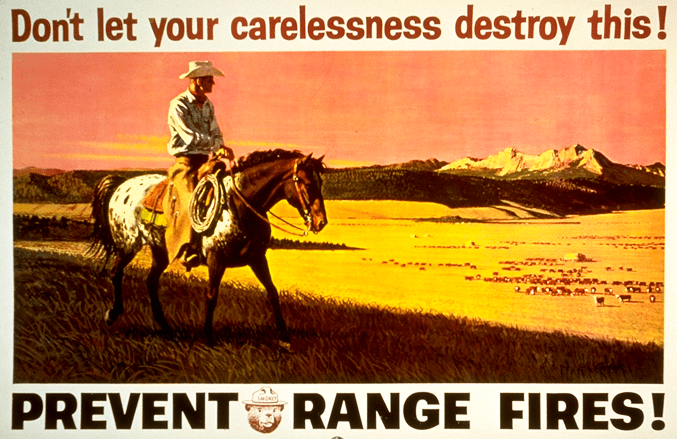Fires Safety & Smokey Bear's Call To Action
Only You Can Prevent Wildfires:
Smokey Bear’s Message Still Rings True

Since 1944, Smokey Bear has reminded us of one powerful truth: “Only YOU can prevent wildfires.” And while this slogan is iconic, it’s more than just a catchphrase. It’s a personal call to action.
With hotter summers, drier conditions, and more people venturing into the outdoors, Smokey Bear's message is more urgent than ever. Wildfires can start in a flash and spread faster than you can imagine. A single spark from a campfire or fireworks can ignite thousands of acres of forest and grassland. When that happens, we lose more than just trees. We lose critical ecosystems, wildlife habitats, and sometimes even human lives and communities.
The forest is home to deer, bears, foxes, birds, and many other creatures. It stores carbon, filters water, and provides us with clean air to breathe. When a wildfire burns through, it jeopardizes all of that — and recovery can take decades or even centuries.
🌲 Why Wildfire Prevention Matters

According to the U.S. Forest Service, 85–97% of all reported wildfires in the United States are caused by human activities, not lightning. These figures are more than just statistics; they represent threatened forests, displaced wildlife, and ecosystems pushed to their limits.
How Fires Start:
1. Fireworks
-
Every year, fireworks spark an estimated 19,000 fires in the U.S., including wildland, structural, and vehicle fires—with around 63% of those occurring around the Fourth of July holiday (American Forest Management).
2. Unattended Campfires
-
Campfires remain one of the leading causes of human-caused wildland fires, particularly when left unattended or poorly extinguished.
-
While precise national percentages vary, many wildfires begin from embers or flames that were not fully extinguished after use.
3. Vehicles & Roadside Heat Sources
-
Sparks or hot exhaust from vehicles parked or driven over dry vegetation are a frequent ignition source.
-
Maintenance issues—like dragging trailer chains or flat tires—can eject hot particles that ignite roadside fires.
-
In 2022, the National Fire Protection Association estimated around 668,500 outside fires, and 222,000 vehicle fires nationwide. While exact cause breakdowns don’t isolate wildfire starts, a notable share result from vehicle-related ignition.

How to Safely Handle Fire:
Campfire Safety
-
Build fires only in approved rings or pits.
-
Keep the fire small and clear of overhanging branches or dry leaves.
-
Never leave a fire unattended.
-
Fully extinguish using the “Drown, Stir, and Cold Test” method:
-
Pour water until hissing stops.
-
Stir embers thoroughly.
-
Touch above the ashes—if it’s still warm, add more water.
-
No Fireworks in or Near Forested Areas
-
Don’t use fireworks in wooded regions or during dry or windy conditions.
-
Many forested or wildfire-prone areas prohibit fireworks entirely.
-
Use only in controlled, non-vegetated areas and keep water or a fire extinguisher on hand.
-
Douse used fireworks in water for at least 15 minutes before disposing properly.
Vehicle Fire Prevention
-
Avoid parking or driving on dry grass or heavy vegetation.
-
Maintain trailers and chains to prevent dragging or sparks.
-
Use spark arrestors on off-road vehicles, and keep mechanical systems in good condition

Smokey Bear’s Timeless Call to Action
“Only YOU can prevent wildfires.”
Human-caused ignition sources—campfires, fireworks, vehicles—are preventable with awareness and care. Your responsible choices can safeguard forests, protect wildlife, and preserve natural wonders for generations to come.
Campfire Safety: How to Put Out a Fire, The Right Way
Campfires and starry nights are part of the magic of a night out camping. But before you head out into the wild, you should know how to extinguish your fire completely:
-
Let it burn down: Allow the firewood to burn completely to ash, if possible.
-
Drown it: Pour water on the fire. Not just a splash — soak it until the hissing stops.
-
Stir the ashes: Use a stick or shovel to stir the wet ashes and embers. Add more water.
-
Touch test: Carefully hover your hand near (not in!) the ashes. If it’s still warm, it’s not out.
-
Repeat if needed: Continue adding water and stirring until everything is cold.
Be Smokey Smart
Wildfire prevention is everyone’s responsibility. Whether you’re camping, hiking, or just enjoying a backyard barbecue near wooded areas, remember:
Always have a way to extinguish fires nearby
Put cigarettes out completely, and toss them in the trash
Check fire danger levels and burn ban restrictions before heading out
Smokey Bear was right in 1944, and he’s still right today: Only YOU can prevent wildfires. It takes just a few moments of awareness and preparation to protect our forests, the animals that call them home, and the generations after us.



